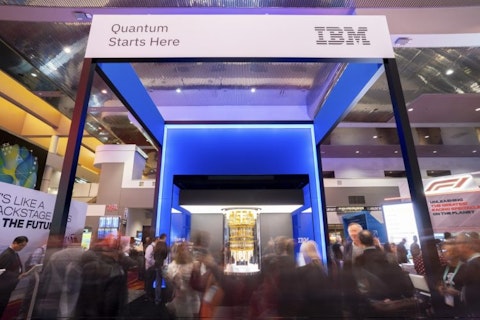Rigetti Computing, Inc. (NASDAQ:RGTI) Q2 2023 Earnings Call Transcript August 10, 2023
Rigetti Computing, Inc. beats earnings expectations. Reported EPS is $-0.13, expectations were $-0.17.
Operator: Good day and welcome to the Rigetti Computing Second Quarter 2023 Financial Results Call. At this time, all participants are in a listen-only mode. After the speakers’ presentations, there’ll be a question-and-answer session. [Operator Instructions] As a reminder, today’s program is being recorded. I’d like to turn the call over to Subodh Kulkarni. You may begin.
Dr. Subodh Kulkarni: Good afternoon, and thank you for participating in Rigetti’s earnings conference call covering the second quarter of 2023. Joining me today is Jeff Bertelsen, our CFO, who will review our results in some detail following my overview. Our CTO, David Rivas, is also here to participate in the Q&A session. We will be pleased to answer your questions at the conclusion of our remarks. We would like to point out that this call at Rigetti’s Q2 2023 press release contain forward-looking statements regarding current expectations, objectives and underlying assumptions regarding our outlook and future operating results. These forward-looking statements are subject to a number of risks and uncertainties that could cause actual results to differ materially from those described and are discussed in more detail in our Form 10-K for the year ended December 31, 2022, our Form 10-Q for the three and six months ended June 30, 2023, and our subsequent filings with the SEC, and other filings with the Securities and Exchange Commission.
We urge you to review these discussions of risk factors. Turning now to the business of the second quarter of 2023. I’m pleased to report our beliefs that we remain on track to reach our year-end technology milestones with our fourth-generation system. After having launched Ankaa-1 internally, we are excited to have our long-time partner Riverlane as the first external partner using the system to work on improving error correction techniques on our new architecture. We also look forward to making our most innovative quantum system available to the general public in Q4 of this year. As previously disclosed, we are continuing to work to improve Ankaa-1 performance with the goal of reaching median 2-qubit fidelity of 98% to support the anticipated Ankaa-2 84-qubit system.
Our Ankaa-2 84-qubit system with anticipated improvements in design and performance is expected to be deployed and made available to external customers in the fourth quarter of 2023. We remain committed to working to achieve median 2-qubit fidelity of 99% with the anticipated Ankaa-2, which we expect to be achieved in 2024, and development of the 336-qubit Lyra™ system thereafter. We also recently announced that we signed a collaboration agreement with ADIA Lab to design, build, execute, and optimize a quantum computing solution intended to address the probability distribution classification problem, which has many direct applications to practical use cases in the investment industry. Tackling real-world computationally challenging problems like this is an important part of working towards narrow quantum advantage.
I’m also very pleased to announce that we recently completed our first QPU sale, which went to a national lab. We delivered a 9-qubit QPU and associated hardware to the lab, which features a square lattice with tunable couplers that can perform entangling 2-qubit gate operations. We are starting to see positive impacts following the implementation of our updated business strategy we announced in February 2023, which is designed to improve our focus, operating efficiency, and preserve cash resources. At our current stage of development, we believe that executing towards our road map and achieving our technology milestones are key to fueling our goal of achieving quantum advantage. We remain focused on meeting our objectives. And with that, I’ll now turn the call over to Jeff, who will review our second quarter 2023 financial performance.
Jeff Bertelsen: Thanks, Subodh. Revenues in the second quarter of 2023 were $3.3 million, compared to $2.1 million in the same period of 2022. Revenue variability is to be expected at this stage of the company’s evolution, given the nature of contract timing with major government agencies. Our development contracts also primarily consist of technical milestone-based work or cost share arrangements, with revenue recognition varying according to the timing of deliverables. Gross margins in the second quarter of 2023 came in at 82%, up from gross margins in the second quarter of 2022 of 59%. The improvement in total gross profit is primarily due to the significant variability in the pricing in terms of our development contracts.
On the expense side, total OpEx in the second quarter of 2023 was $19 million, compared to $27 million in the same period in the prior year. The year-over-year decrease was primarily due to a reduction in stock compensation expense. Other decreases in the second quarter of 2023 included lower professional fees and lower employee wages and benefit costs, resulting from our February 2023 reduction in workforce. The change in the fair value of the forward agreement for the ampere warrant increased G&A expense by $44,000 in the second quarter of 2023, compared with a 2.1 million reduction in G&A expense in the second quarter of 2022. In the second quarter of 2023, stock compensation expense totaled $3.4 million, and depreciation and amortization expense totaled $2.2 million, compared to $11 million and $1.6 million in the second quarter of 2022 respectively.
Operating loss for the second quarter of 2023 was $16.2 million, compared to an operating loss of $25.8 million for the same period of 2022. Net loss for the second quarter of 2023 was $17 million or $0.13 per share, compared to a net loss of $12.3 million or $0.11 per share for the same period of 2022. Net loss for the second quarter of 2022 was favorably impacted by changes in the liability for the urn out and derivative warrant liabilities of $6.6 million and $8 million respectively. Cash, cash equivalents, and available for sale investments totaled $105.5 million as of June 30, 2023, compared with $122 million as of March 31, 2023. During the second quarter of 2023, we raised $2.348 million from the sale of 1.869 million shares of common stock under our common stock purchase agreement with B.
Riley. Based on our current operating plan, we expect to have cash, cash equivalents, and available for sale securities of between $65 million and $75 million at the end of 2023. At this time, based on our current operating plan, we anticipate that Regetti will need to raise additional funding by late 2024 or early 2025 to continue its research and development efforts and achieve its business objectives. Thank you. We would now be happy to answer your questions.
See also 11 Best Local Bank Stocks to Buy and Rob Citrone Podcast and Stock Picks.
Q&A Session
Follow Rigetti Computing Inc.
Follow Rigetti Computing Inc.
Operator: Thank you. [Operator Instructions] Our first question comes from Quinn Bolton with Needham & Company. Your line is open.
Quinn Bolton: Hey, guys. Congratulations on the technical progress in the quarter. Great to see your sell-on track for the 98% to qubit. I guess Subodh wanted to ask, kind of great to see the first QPU sale in the second quarter, wondering a couple of things. First, of the 3.3 million, can you quantify how much of that is more development contracts versus the QPU sale? Then perhaps a more important question looking forward, are you now starting to see greater interest from national labs, other government agencies, and perhaps even on the commercial side, growing interest in the sale of complete systems, and could that become a meaningful portion of the revenue stream for the business going forward? Thank you.
Dr. Subodh Kulkarni: Thanks Quinn. Excellent questions. So first question regarding the revenue breakdown, majority of it is still coming from research contracts, although the QPU sale obviously contributed. We don’t want to quantify the exact price of 9-qubit QPU for obvious reasons, but suffice it to say for customers who have dilution refrigerators in their position, the price for a 9-qubit QPU is going to be under a million dollars. So that gives you a frame of reference of what we are talking about here. So the majority of the revenue still comes from DOE, DOD type contracts, and cloud service obviously, AWS Azure as well as our cloud, they all contributed as well during the quarter. Now for the more important and exciting part of your question is to what do we think will happen to the QPU sales pipeline, if you will, that’s what you are getting at.
Suddenly we are very, very excited to see the interest we saw from the first sale we did with the national lab and the pipeline that seems to be coming along. Lot of customers are expressing interest in a 9-qubit QPU, particularly with the tunable coupler and the performance you get with the 9-qubit. Most of the applications are research applications, so for things like optimized control and pulse design, or materials research, or simple algorithmic research, basic characterizations, measurements, student training, that kind of stuff. So primarily research, we certainly still are not anywhere close to quantum advantage or even narrow quantum advantage, so it’s mostly being used for research purposes. But there are many customers who are interested in having an on-premise QPU for various reasons, security, trying to see how the hybrid climate works in their environment, and so on.
So certainly we are very excited to see the interest that seems to be emerging with the 9-qubit, and we definitely think it will be a good contributor to our sales and margins. At the price points I mentioned, we make fairly healthy margins, so we feel pretty comfortable that this will be a good potential revenue stream that could help us with our cash situation. Hopefully that answers your questions.
Quinn Bolton: Yes, no, that was great. I guess a couple of follow-ons. First, you mentioned, customers, if they’re buying a QPU, they have to have their own dilution refrigerator. I know dilution refrigerators are pretty expensive, so I’m assuming that this is just for the QPU, the dilution refrigerator is purchased directly by the customer that’s not included in the sale.
Dr. Subodh Kulkarni: Yes, in general. I mean, we can obviously sell them the whole system if they want to, but many customers that we are talking about, as I said, it’s primarily for research purposes, they already have purchased a dilution refrigeration system, so no point in trying to sell them the whole thing when they already have it, and we can ship them a finished QPU, if you will, in a FedEx or UPSI box, and literally it just has to be plug-and-play kind of a system where they can immediately attach it to their existing dilution refrigeration system and get it working fairly quickly. So it’s a fairly simple operation to ship and get it plugged into their environment and get it going. If they want to buy the whole system from us, including the DR, obviously the price point will be higher, roughly in the 22.5 in the range for the 9-qubit system, but we are primarily focused on customers who already have a DR and are interested in just buying the QPU from us.





